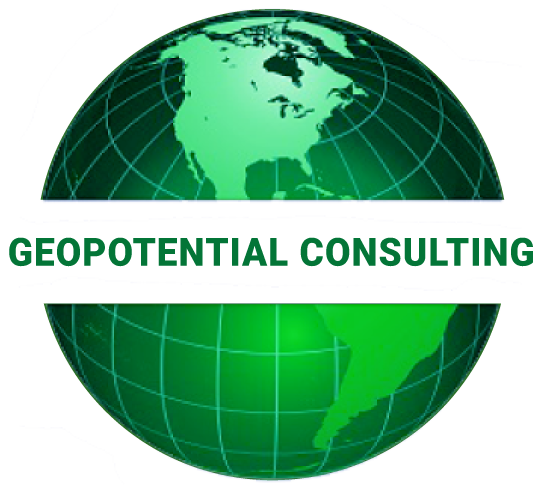Our Blog
Our blog contains news, articles, and information about the latest developments in the engineering world.
The Rise of Geothermal Heating in Urban Areas: New York
In 2015, at the Conference of Paris (COP), The United Nations Framework Convention on Climate Change (UNFCCC) came to an agreement that an ambitious undertaking for combating climate change was necessary . To put the dire situation into perspective, it is stated that half a million people die a year due to outdoor air pollution . In order to put this goal into motion, there is a need for not only a financial commitment but also a push for innovation. The largest city attempting to accomplish the goal of lowering greenhouse emissions by 80% by 2050 is New York. Interestingly enough, 70% of New York’s greenhouse gas emissions are due to “dirty buildings” . The state challenged these so called “dirty buildings” to clean up their act or face the consequence of fines as high as one million dollars. It is written that large buildings are to cut their emissions by 40% by 2030 and 80% by 2050. While these goals are ambitious; they can be accomplished with an overhaul of efficient energy systems. Large buildings and Universities alike are looking toward geothermal energy for its potential as an efficient energy system. University research, Laws, and strict guidelines are paving the way for a rise in Geothermal energy in New York City.
University Innovation
Cornell University in Ithaca New York uses Cayuga Lake as a source for cooling its campus (Figure 1). The campus has reduced electricity consumption for central campus air by 86% and over all electricity use by 10 percent. In their “Earth Source Heat Project,” Cornell proposes to circulate initially cool water through subsurface reservoirs, where it will be naturally heated by the warmer temperature of the rocks. The school director projects that the entire project from research to drilling may be accomplished within 6 years, but faculty and students alike agree this is a rough estimate. Universities such as Cornell are providing research for the New York area to grasp a better understanding of energy efficient systems. However under the City itself is there easement for a project as such?
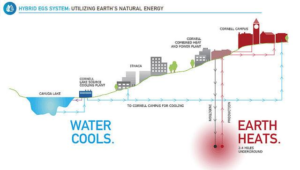
City Innovation
Upon first glance it may be questioned if geothermal energy can be implemented in the sparse available easement in the city. After a study was commissioned by the state government in 2015 it was determined that it was not only possible, but that there were multiple ways that geothermal systems could be implemented in these tight places. A year later, New York Mayor De Blasio signed a bill “requiring all City owned buildings to undergo a cost efficiency analysis to determine favorability of geothermal systems.” Trevor Day School was the first educational institution to contribute to the Mayor’s Geothermal goals (figure 2) (“NYC building”). The School is heated and cooled by energy piles. Geothermal energy piles use the near constant temperature of the ground to heat and cool spaces.

Geothermal heat piles are a relatively new energy technique. The piles of the building strategically provide dual functionality. In more detail, the piles both support the building as well as provide geothermal heating and cooling. It works by employing a closed piping system within the pile itself (figure 2). Within the pipes there is a mixture of water and some form of antifreeze. This fluid moves through the pipes by means of a heat pump. This system is convenient for its dual responsibility, efficiency and affordability. In spite of its convenience; there is little comprehensive data with regard to heat piles. More specifically there is a lack of calculation methods for the design of geothermal heat piles. The complex interaction between the thermal storage and mechanical behavior of the structure is not fully understood within the design. Because of the lack of information, the safety factor for the piles is considerably increased. Not only that, but while the energy pile are efficient; construction workers argue that they are costly because they require “nonstandard construction skill”. The use of energy piles continues to be both common as well as questionable.
Conventional HVAC Systems: The Environmental Impact
The effects of antifreeze and green house gas from traditional air source HVAC are seen on a local, national and global level. Contamination of heat islands and global warming are devastating effects of traditional energy-extensive consumption HVAC units. The extremity of these HVAC system negatives has left the government focused on a new system all together rather than placing bandaids on the problem. New green technology such as geothermal system and solar system are growing in popularity with improved efficiency.
Antifreeze and the Environment
One major negative outcome of using high energy consuming HVAC systems is that they contribute to global warming. More specifically, HVAC systems both release CO2 as well as employ HFCs; both of which are greenhouse gases that trap heat and deplete the ozone layer. During the manufacturing process, if the units are disposed, these HFCs may become hazardous. Although they are emitted from the system less often and likely than CO2, HFCs are more potent in the atmosphere. HFCs trap thousands of times more heat than CO2 .
Prior to 2010, most air conditioning units installed in the US used a refrigerant called R-22 commonly referred to as Freon. R-22 is a hydrochlorofluorocarbon, which is a greenhouse gas and is therefore extremely detrimental to the ozone layer. Because of the extensive damage to the ozone layer, the US government banned the installation of new units using R-22 as of 2010. Today, new air conditioning units use (R-410A) Puron, which is a HFC with little to no ozone depletion but high global warming potential. In fact R-410A has a higher global warming potential than R-22. This means that R-410A releases more Than R-22 so it is questioned if the switch is as beneficial as the market plays it off to be.
Currently research is being done to evaluate R-32 which has both no ozone depletion and very low potential for global warming in spite of being a HFC much like R-410A. The problem with R-32 is that it is much more difficult to handle in comparison to other refrigerants. Figure 1 illustrates the comparison between the three refrigerants discussed.
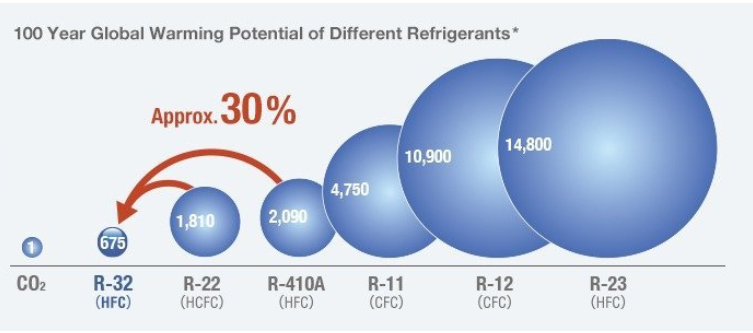
The effects of antifreeze and green house gas from traditional air source HVAC are seen on a local, national and global level. Contamination of heat islands and global warming are devastating effects of traditional energy-extensive consumption HVAC units. The extremity of these HVAC system negatives has left the government focused on a new system all together rather than placing bandaids on the problem. New green technology such as geothermal system and solar system are growing in popularity with improved efficiency.
Antifreeze and the Environment
One major negative outcome of using high energy consuming HVAC systems is that they contribute to global warming. More specifically, HVAC systems both release CO2 as well as employ HFCs; both of which are greenhouse gases that trap heat and deplete the ozone layer. During the manufacturing process, if the units are disposed, these HFCs may become hazardous. Although they are emitted from the system less often and likely than CO2, HFCs are more potent in the atmosphere. HFCs trap thousands of times more heat than CO2 .
Prior to 2010, most air conditioning units installed in the US used a refrigerant called R-22 commonly referred to as Freon. R-22 is a hydrochlorofluorocarbon, which is a greenhouse gas and is therefore extremely detrimental to the ozone layer. Because of the extensive damage to the ozone layer, the US government banned the installation of new units using R-22 as of 2010. Today, new air conditioning units use (R-410A) Puron, which is a HFC with little to no ozone depletion but high global warming potential. In fact R-410A has a higher global warming potential than R-22. This means that R-410A releases more Than R-22 so it is questioned if the switch is as beneficial as the market plays it off to be.
Currently research is being done to evaluate R-32 which has both no ozone depletion and very low potential for global warming in spite of being a HFC much like R-410A. The problem with R-32 is that it is much more difficult to handle in comparison to other refrigerants. Figure 1 illustrates the comparison between the three refrigerants discussed.
Carbon Demands
Air conditioners have an environmental impact in more ways than one, but the most significant are the inputs and the outputs. Air conditioning units are powered by electricity which demands the burning of fossil fuels. The effects of electricity production alone can be very detrimental to the world in which we live. As stated prior; is a major variable when it comes to air conditioning. In fact, nearly 90% of homes in America have air conditioning units; accounting for approximately 6% of the country’s residential energy uses. Each year keeping us cool these units produce about 100 million tons of carbon dioxide. And although some may not believe these effects, it can undoubtedly be both head and felt. Cities are about 10° F hotter than suburbs and rural areas because they use more HVAC systems. These hot urban areas are referred to as heat islands. The cycle seems to be never ending. As we demand to stay “cool”, we actually warm the earth even more.
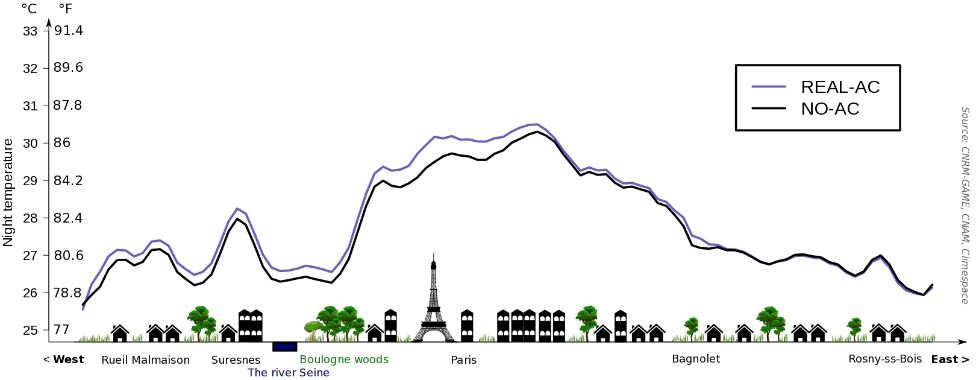
Reference
[1] Dunbar, Brian. “Satellites Pinpoint Drivers of Urban Heat Islands in the Northeast.” NASA,
NASA, www.nasa.gov/topics/earth/features/heat-island-sprawl.html.
[2] Environmental Working Group. “EWG’s Tap Water Database: What’s in Your Drinking Water?”
EWG Tap Water Database, www.ewg.org/tapwater/system.php?pws=VA610730.
[3] Fletcher, Jenna. “Refrigerant Poisoning: Causes, Symptoms, and Treatment.” Medical News
Today,
MediLexicon International, www.medicalnewstoday.com/articles/322165.php.
[4] “Forums.” Global Warming Potential vs Ozone Depletion Potential,
www.hvactechgroup.com/hvacforum/index.php?topic=211.0.
[5] Olson, David. “City Shuts 2 Water Wells after Finding Pollution.” Newsday, Newsday, 29 Jan.
2018,
www.newsday.com/long-island/nassau/glen-cove-wells-freon-water-pollution-1.16399663.
Invest in Green Energy System-Compliments of our Earth
In order to finance the installation of geothermal heat exchangers, several states have implemented a C-PACE program . C-PACE works as a financial tool for green energy including geothermal, solar energy and wind power. Geopotential can assist the client to secure a C-PACE loan, connecting them with the right organizations.
What’s C-PACE
C-PACE (Commercial Property Assessed Clean Energy) enables property owners to finance improvements to their property and has been enabled in more than 33 states as of 2019. C-PACE also helps governments to create jobs, retain businesses, and keep dollars in the local economy without raising taxes.
C-PACE is a government policy based on the principle that commercial energy projects are public benefits similar to sewers, roads, and bridges.
How C-PACE helps green energy?
C-PACE authorizes counties to work with private capital providers to provide upfront financing to commercial property owners for qualifying improvement projects, and to collect the repayment through annual or semi-annual surcharges on the property’s tax bill.
C-PACE can be applied on commercial property, industrial facility, agriculture facility and non-profit project. The following facilities are eligible for C-PACE finance: Solar Energy Equipment, High-Efficiency Lighting and Building System, High-Efficiency Boilers and Furnaces and Heating Ventilation, Air Conditioning (HVAC) Upgrades, High-Efficiency Hot Water Heating Systems, Combustion and Burner, Building Shell or Envelope Improvements, Building System Energy Management Systems and Process Equipment Upgrades, Geothermal Energy Devices, Water Conservation.
C-PACE in Virginia
Several localities across the Commonwealth have established or are currently developing C-PACE programs.
Arlington County was the first locality in Virginia to offer a Commercial Property Assessed Clean Energy (C-PACE) program in January 2017. And officially launched their program in January 2018.
C-PACE in Maryland
C-PACE administration in Maryland is local level. Only Montgomery and Prince George’s counties have not opted into the MD-PACE Program.
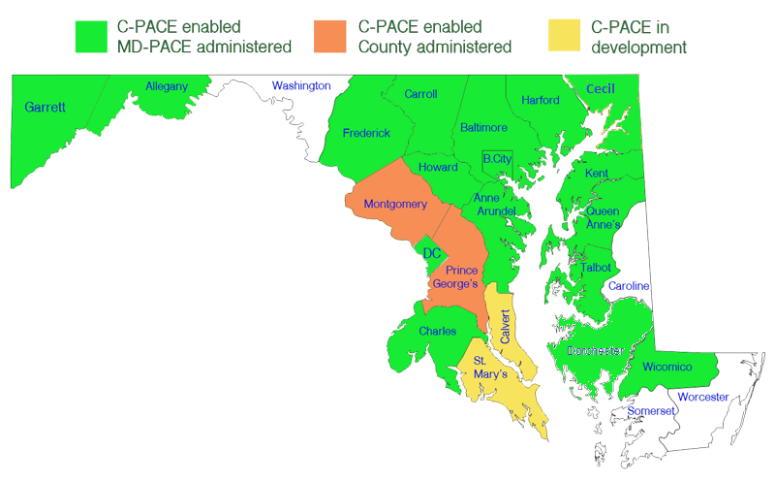
C-PACE and Geopotential
Geopotential has been working with several non-profit organizations, who are eligible for the C-PACE program, via geothermal heat exchangers and lighting installations. GPC has provided geothermal feasibility analysis according to local subsurface thermal properties, for the organizations and are assisting these organizations to facilitate the C-PACE process.
Reference link:
LEED – Constructing for a Healthier Environment
What is LEED?
Leadership in Energy and Environmental Design (LEED), developed by the non-profit U.S. Green Building Council (USGBC), is a certification program focused primarily on new, commercial-building projects and based upon a points system for certification. It is the most widely used green building rating system in the world and is actually available for all kinds of building, community and home project. LEED contains a set of rating systems for the design, construction, operation, and maintenance of the green buildings, that aims to help building owners and operators to be environmentally responsible and use resources efficiently. This certification is a globally recognized symbol of sustainability achievement. Buildings can be qualified for four different levels of certification: Certified, Silver, Gold and Platinum, depending on the points earned. The Empire State Building in New York is one of the world’s most iconic LEED certified building at the Gold level. Another remarkable LEED certified building is the Chinatown Public Library in Chicago, which uses low energy LED lighting and radiant heating and cooling system.
What are the benefits of LEED Certification?
There are a number of answers to this. First and most importantly, it saves money in the long run. According to the World Green Building Council, green buildings achieving LEED certification in the US and other countries have been shown to consume 25 per cent less energy and 11 per cent less water than non-LEED certified buildings. Additionally, if your building meets LEED standards, it is very likely that you may be eligible for certain government tax credits. Moreover, Buildings that are built and operated in ways that are not environmentally-friendly often contain unhealthy indoor environments. Many of the people that work in such environments for a period of time would not feel well due to what’s known as “Sick Building Syndrome”. Sick building syndrome causes absenteeism and a drop in productivity, this is why creating a healthy indoor environment is very essential. The healthier your indoor environment is, the more comfortable it will be. Last but not least, LEED certification is a great marketing tool too. A building with LEED certification, at any level, shows a vested interest from ownership. It shows that the building is updated (if not brand new) in order to run efficiently and help save tenant’s utility costs. Having the certification shows that thought, care and capital were put into the building and its effect on the environment and its occupants. This can be attractive to potential tenants or buyers.
The main concern of getting LEED certification, however, is probably the fact that it adds costs to construction. The program is funded in large part by building owners paying large sums for certification. The minimum cost for certifying a building is approximately $2,900, but the price tag quickly jumps for bigger projects. Office buildings and hospitals can cost upwards of approximately $1 million just to be LEED certified. Even though it is expensive and difficult to be LEED certified, for all the benefits it can bring, it might be worth the initial capital investment, many times over.
We at GeoPotential Consulting pride ourselves to be an LEED compliant firm, with LEED certified engineers on board assisting with and designing solutions for a greener world.

Geothermal Growth
Geothermal HVAC systems have been developed for more than 60 years in the U.S. and other countries. People have been adapting them because of a lot of reasons. They are friends with our nature. In fact, the U.S. Department of Energy and the U.S. Environmental Protection Agency (EPA) states that, geothermal HVAC systems are the most energy efficient, environmentally friendly, and cost-effective HVAC systems available. Due to the increasing demand for renewable, sustainable, and cost-effective energy solutions, the geothermal heat pump market is expanding rapidly in the coming years, especially with several beneficial initiatives taken by the U.S. Government and European Union, including financial supports, federal income tax credits, rebates, subsidies, renewable heat incentives.
As a matter of fact, geothermal heating and cooling is the standard in many European countries. In Sweden and Switzerland, more than 75% of new homes have geothermal HVAC systems. Geothermal heating and cooling is a success story in Europe as it shows a rapid and dynamic expansion in the past years. An EGEC Market Report done in 2017 states that, geothermal district heating accounts for over 4.9 Giga Watts of capacity in Europe, with 294 plants currently in operation. The number of new plants coming online each year is on an upward trend, with an average annual growth rate of 10% in recent years. The development of geothermal as a solution for heating and cooling is particularly dynamic in Germany, where 35 projects are planned or in developments, but many smaller or newer markets are also increasingly investing in geothermal energy.
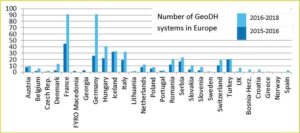
EGEC Market Report 2014
On the other hand, U.S. geothermal heat pump market size for 2016 was valued over USD 20 billion. Availability of constant shallow ground temperature throughout the country will boost the product demand. Growing focus towards development of renewable energy with aim to reduce environment pollution also drives the China market share. In 2016, China government announced to triple its geothermal energy consumption to 72.1 million ton of coal equivalent by 2020 when compared with current levels. According to a report by Global Market Insights lnc, geothermal heat pump market size for 2016 was valued over USD 80 billion, projected to cross a revenue of USD 130 billion by 2024, and is set to exceed 110 GW by 2024. We can see that geothermal heating and cooling systems are having a steady growth in the future.
However, there are still barriers limiting the growth of the market. According to a new study from Persistence Market Research, high installation cost of geothermal heat pumps systems along with lack of consumer awareness or confidence in geothermal heat pump’s benefits is acting as major challenge in overall acceptance of this technology in major developing countries around the globe. Even though there are limiting factors on geothermal heat pumps development’s path, with the government’s assistance, technology development, and increasing understanding of the systems, the barriers are expected to be removed gradually. Hence, we should keep the hope that the geothermal heating and cooling systems will be widely used domestically, commercially, and industrially.
